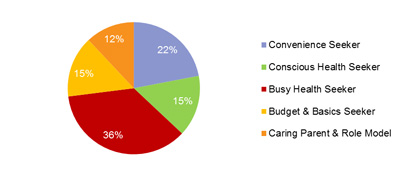Natural Colour? What does this really mean to the consumer? Part 2
- Like
- Digg
- Del
- Tumblr
- VKontakte
- Buffer
- Love This
- Odnoklassniki
- Meneame
- Blogger
- Amazon
- Yahoo Mail
- Gmail
- AOL
- Newsvine
- HackerNews
- Evernote
- MySpace
- Mail.ru
- Viadeo
- Line
- Comments
- Yummly
- SMS
- Viber
- Telegram
- Subscribe
- Skype
- Facebook Messenger
- Kakao
- LiveJournal
- Yammer
- Edgar
- Fintel
- Mix
- Instapaper
- Copy Link
Posted: 2 August 2016 | Guido de Jager | No comments yet
In Part 2 of his review of the global survey on colour, Guido de Jager discusses consumer preference and consumer type…


|
In this three part series, Guido de Jager discusses the results of a global survey that revealed detailed insights into consumer behaviour and preferences for natural colours and flavours. In Part one, Guido described the methodology for the survey and key findings from the results. In this part, Guido discusses consumer types. |


The research identified that consumers are confused, with 67% of consumers looking for easy to understand ingredient information. The use of various terms including natural and negative claims such as “free from” and “no artificial” have been widely adopted throughout the food industry. However, today’s consumers are savvy and as their knowledge develops it is increasingly important to inform what is in the product rather than use claims about what is not. On a global basis consumers perceive products with natural claims to be suspicious with 45% of consumers stating that they do not believe brands that claim to be natural. These findings clearly demonstrate a need to build trust and communicate a positive message.
However, not all consumers are the same
Still, the demand for naturalness has to be reconciled with different lifestyles and expectations. In the course of the survey, a total of five different consumer types have been identified, which are distributed around the globe and all have different priorities with regard to their diet:
The Conscious Health Seeker – Attention for a balanced diet
The first of the five consumer types, the Conscious Health Seeker, accounts for 15 percent of the population worldwide. For them, healthy food and beverages are right at the top of the agenda. Conscious Health Seekers pay special attention to a balanced diet and natural ingredients investing a huge amount of time and money in a healthy lifestyle. Women and the elderly, whose children have already left home, are particularly well represented in this group. It is most strongly represented in France and Germany, where it makes up a quarter of the population in total.
The Busy Health Seeker – Health concerned consumers with limited time
Another consumer type that is characterised by a particularly keen interest in healthy foods, is the Busy Health Seeker who make up 36 percent of all consumers and thus constitute the largest group worldwide. For them, however, the wish for naturalness has to be brought in line with a hectic lifestyle. Most of the Busy Health Seekers don’t have the time to engage in detail with food and their ingredients. This consumer type is very widely represented in Asia, where it accounts for 66 percent of the population.
The Caring Parent / Role Model – Children are the motivation for natural goodness
Additionally, there are consumers whose role as parents motivates them to opt for a healthy, natural diet. Caring Parents are usually aged between 35 and 44, female, and have children under 12. Out of concern for their offspring and in order to be a good role model, they attach particular importance to healthy, natural food and beverages. In Indonesia
(17 percent), Spain (16 percent) and Brazil (14 percent), this type of consumer is widespread. Around the globe, 12 percent of all consumers belong to the Caring Parents.
The Budget & Basics Seeker – Affordability is paramount
For the Budget and Basics Seekers, the main factors arising in connection with food and beverages are the preparation time and pricing. Even though they are on average concerned about healthy food, cooking primarily has to be affordable and uncomplicated for them. The Budget and Basics Seekers account for 15 percent of the globally interviewed consumers. They are typically older than 45, and have children still living at home. They are particularly prominent in France and Germany (24 percent each).
The Convenience Seeker – Food has to be convenient
The last consumer group are the so-called Convenience Seekers. From a global perspective, they make up 22 percent of all consumers. For them, it’s particularly important that food can be prepared quickly and conveniently therefore compromising a healthy and balanced diet. Predominantly male (59 percent) Convenience Seekers are mostly young singles aged between 18 and 34. In the United Kingdom, this type of consumer constitutes the largest (39 percent) share of all consumers. In the USA (29 percent of the respondents), France (29 percent) and Germany (28 percent).
Therefore, the main group of consumers determining and demanding the global trend for naturalness are made up of the Busy Health Seekers, Caring Parents and Conscious Health Seekers, equating to 63 percent of the population worldwide.
Global distribution of different consumer types


Next week, in the final part of his review of the global survey on colour, Guido de Jager discusses product labelling and opportunities for the food and drink industry.
Related topics
Clean Label, Flavours & colours, Natural, Packaging & Labelling









